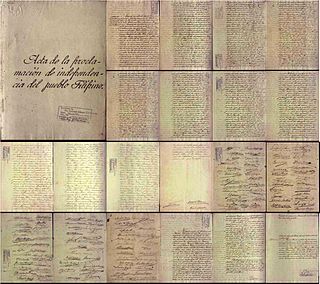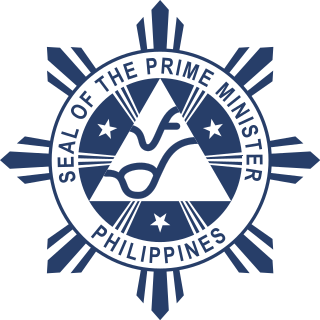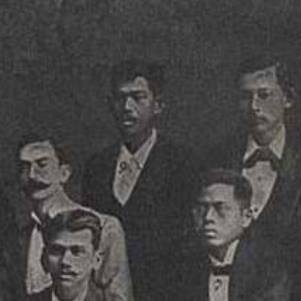
Emilio Aguinaldo y Famy was a Filipino revolutionary, statesman, and military leader who is the youngest president of the Philippines (1899–1901) and became the first president of the Philippines and of an Asian constitutional republic. He led the Philippine forces first against Spain in the Philippine Revolution (1896–1898), then in the Spanish–American War (1898), and finally against the United States during the Philippine–American War (1899–1901).
This article presents a timeline of Philippine political history focused on governmental transitions of the Philippine archipelago, major polities, invasion attempts, and insurgency movements from the pre-Hispanic period to the present. The information presented here is highly summarized, and more complete information can be found in more detailed articles linked below.

The Philippine–American War, known alternatively as the Philippine Insurrection, Filipino–American War, or Tagalog Insurgency, was fought between the First Philippine Republic and the United States from February 4, 1899, until July 2, 1902. Tensions arose after the United States annexed the Philippines under the Treaty of Paris at the conclusion of the Spanish–American War rather than acknowledging the Philippines' declaration of independence, developing into the eruption of open battle. The war can be seen as a continuation of the Philippine struggle for independence that began in 1896 with the Philippine Revolution against Spanish rule.

The Philippine Revolution was a conflict waged by the Filipino revolutionaries against the Spanish colonial authorities in an attempt to win the archipelago's independence.

Miguel Malvar y Carpio was a Filipino general who served during the Philippine Revolution and, subsequently, during the Philippine–American War. He assumed command of the Philippine revolutionary forces during the latter, following the capture of resistance leader Emilio Aguinaldo by the Americans in 1901. According to some, he could have been listed as one of the presidents of the Philippines; however, as of 2023, is not recognized as such by the Philippine government.

The Philippine Declaration of Independence was proclaimed by Filipino revolutionary forces general Emilio Aguinaldo on June 12, 1898, in Cavite el Viejo, Philippines. It asserted the sovereignty and independence of the Philippine islands from the 300 years of colonial rule from Spain.

The prime minister of the Philippines was the official designation of the head of the government of the Philippines from 1978 until the People Power Revolution in 1986. During martial law and the fourth republic, the prime minister served as the head the Armed Forces of the Philippines. A limited version of this office, officially known as the President of the Council of Government, existed temporarily in 1899 during the First Philippine Republic.
The Philippine–American War, also known as the Philippine War of Independence or the Philippine Insurrection (1899–1902), was an armed conflict between Filipino revolutionaries and the government of the United States which arose from the struggle of the First Philippine Republic to gain independence following the Philippines being acquired by the United States from Spain. This article lists significant events from before, during, and after that war, with links to other articles containing more detail.

The Philippine Republic, now officially known as the First Philippine Republic and also referred to by historians as the Malolos Republic, was established in Malolos, Bulacan during the Philippine Revolution against the Spanish Empire (1896–1898) and the Spanish–American War between Spain and the United States (1898) through the promulgation of the Malolos Constitution on January 22, 1899, succeeding the Revolutionary Government of the Philippines. It was formally established with Emilio Aguinaldo as president. It maintained governance until April 1, 1901.

The history of the Philippines from 1898 to 1946 began with the outbreak of the Spanish–American War in April 1898, when the Philippines was still a colony of the Spanish East Indies, and concluded when the United States formally recognized the independence of the Republic of the Philippines on July 4, 1946.
The elections for the Malolos Congress, also known as the Revolutionary Congress, were held in the Philippines from June 23 to September 10, 1898.

The Political Constitution of 1899, informally known as the Malolos Constitution, was the constitution of the First Philippine Republic. It was written by Felipe Calderón y Roca and Felipe Buencamino as an alternative to a pair of proposals to the Malolos Congress by Apolinario Mabini and Pedro Paterno. After a lengthy debate in the latter part of 1898, it was promulgated on January 21, 1899.
Listed here are the heads of state and government of the Philippines, from the Spanish occupation up to the current Republic.
The sovereignty of the Philippines refers to the status of the Philippines as an independent nation. This article covers sovereignty transitions relating to the Philippines, with particular emphasis on the passing of sovereignty from Spain to the United States in the Treaty of Paris (1898), signed on December 10, 1898, to end the Spanish–American War. US President William McKinley asserted the United States' sovereignty over the Philippines on December 21, 1898, through his Benevolent Assimilation Proclamation.

The Hong Kong Junta was an organization formed as a revolutionary government in exile by Filipino revolutionaries after the signing of the Pact of Biak-na-Bato on December 15, 1897. It was headed by Emilio Aguinaldo and included high-level figures in the Philippine revolution against Spanish rule who accompanied Aguinaldo into exile in the Crown Colony of Hong Kong from the Philippines.

Pedro Tongio Liongson was a member of the Malolos Congress which wrote the constitution of the First Philippine Republic in 1899 and served as First Director of Military Justice in the Republic's army during the Philippine–American War of 1899–1901. A trained lawyer and judge, Col. Liongson figured in and left his mark on a number of historic events in the Philippines.

The United States Military Government of the Philippine Islands was a military government in the Philippines established by the United States on August 14, 1898, a day after the capture of Manila, with General Wesley Merritt acting as military governor. During military rule (1898–1902), the U.S. military commander governed the Philippines under the authority of the U.S. president as Commander-in-Chief of the United States Armed Forces. After the appointment of a civil Governor-General, the procedure developed that as parts of the country were pacified and placed firmly under American control, responsibility for the area would be passed to the civilian.

Salvador Estrella was a Filipino general who fought in the Philippine Revolution and the Philippine–American War. For his courage in battle, he earned the moniker "red blooded."

The Revolutionary Government of the Philippines was a revolutionary government established in the Spanish East Indies on June 23, 1898, during the Spanish–American War, by Emilio Aguinaldo, its initial and only president. The government succeeded a dictatorial government that had been established by Aguinaldo on June 18 and was dissolved and replaced by this government upon its establishment. This government endured until January 23, 1899, when the proclamation of the Malolos Constitution established an insurgent Philippine Republic government that replaced it.

The Dictatorial Government of the Philippines was an insurgent government in the Spanish East Indies inaugurated during the Spanish–American War by Emilio Aguinaldo in a public address on May 24, 1898, on his return to the Philippines from exile in Hong Kong, and formally established on June 18. The government was officially a dictatorship with Aguinaldo formally holding the title of "Dictator". The government was succeeded by a revolutionary government which was established by Aguinaldo on June 23.















